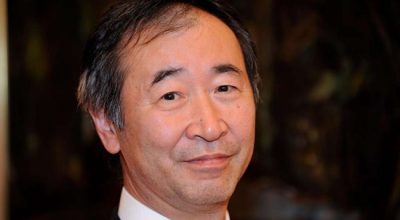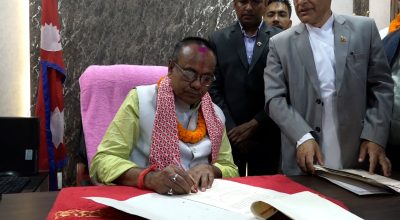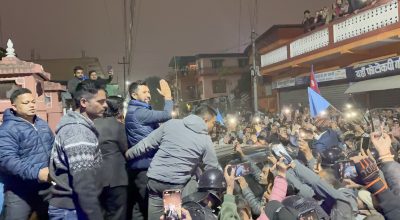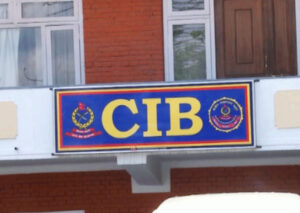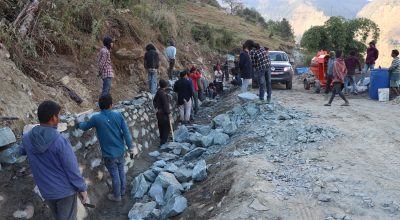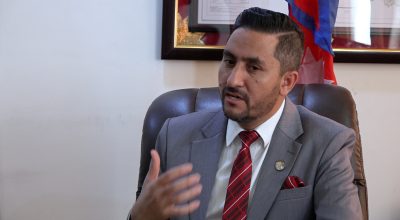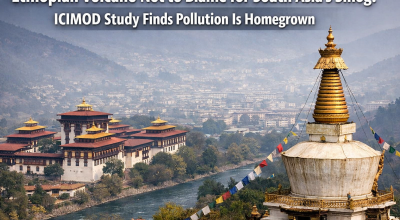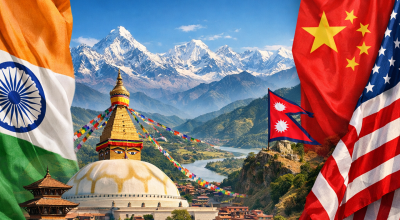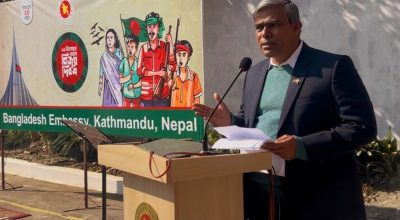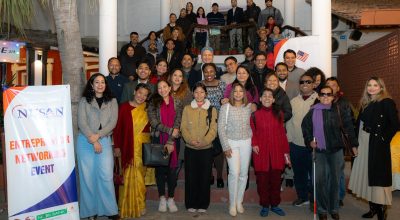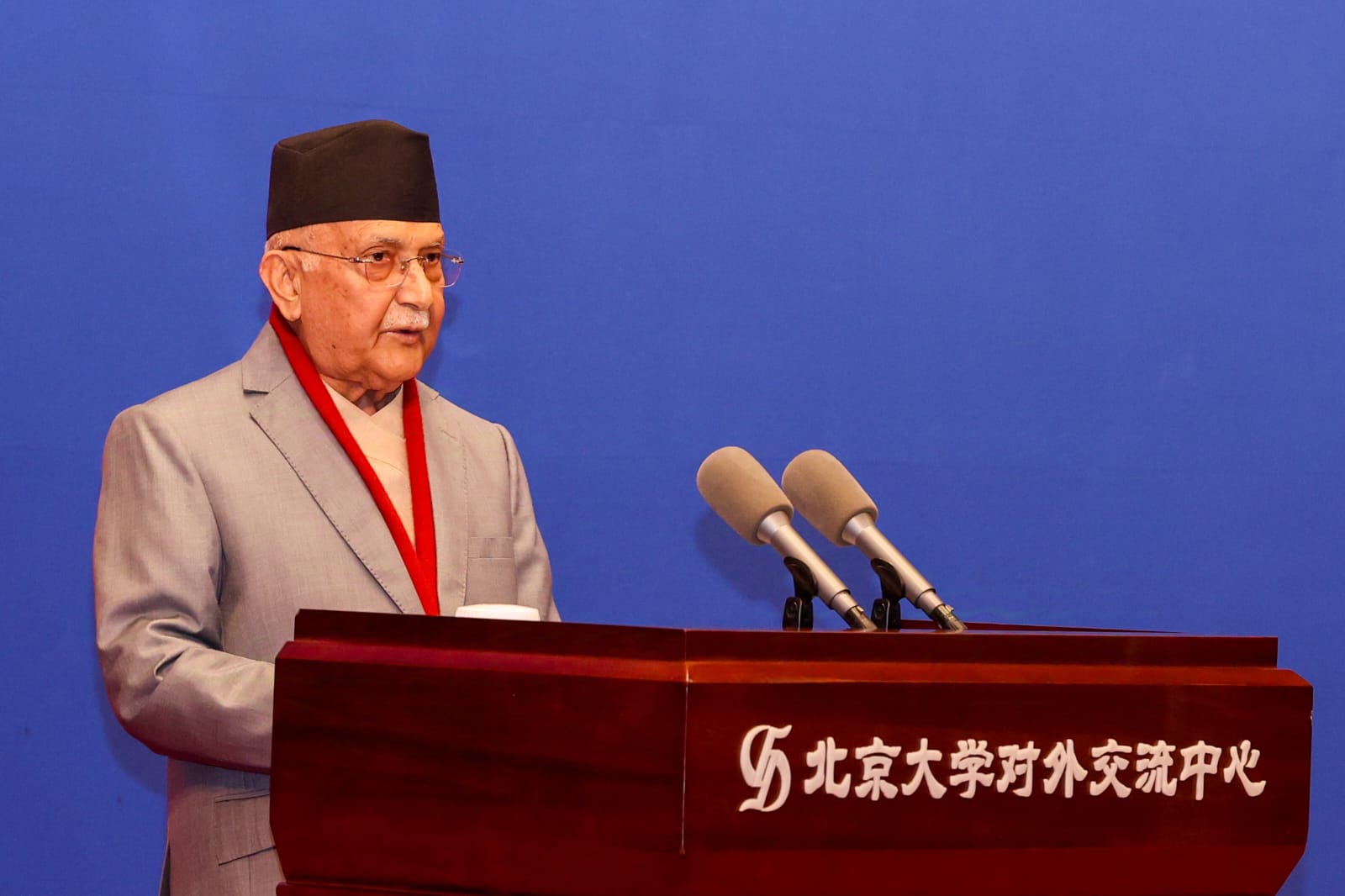
Beijing, Dec 4: Visiting Prime Minister KP Sharma Oli has said that Nepal would reap benefits from the Belt and Road Initiative (BRI).
In his address to a programme held at Peking University, PM Oli expressed the belief that China has strongly supported Nepal’s development and the BRI project initiated under the visionary leadership of President Xi Jinping would further deepen bilateral relations between the two countries.
On the occasion of the 70th anniversary of the establishment of diplomatic relations between Nepal and China in 2025, PM Oli said that high-level visits would be exchanged between the two countries to add a new dimension to the bilateral relations.
The Prime Minsiter further said that an old university like Peking could also contribute to the educational development of Nepal.
PM Oli was welcomed by University Chair Prof Gong Qihuang. Other members of the prime minister-led delegation were also present on the occasion.
Prime Minister Oli is also scheduled to address the Nepal China Business Forum today itself.
full text
I feel singularly privileged to join you all and speak to this august gathering of intellectuals, aspiring scholars, and esteemed friends of Nepal.
I extend my profound gratitude to the President of the University for his generous invitation. This opportunity to be here at the University with a glorious patriotic tradition has moved me profoundly.
While in my youth, I had read of the inspiring stature of the Peking University. The anti-imperialist and anti-feudal May Fourth Movement began at this University in 1919. That movement was an important turning point in the history of modern China.
And it is my privilege to stand here today—in this institution having a rich and resilient history,
– with exemplary excellence,
– which has given so many stellar alumni.
As I stand here at “Yan Yuan” , it is indeed a matter of pleasure to interact with the professionals and students who are at this temple of knowledge, and cradle of creativity. This atmosphere, which is full of academic energy and spark is truly inspiring.
In our Sanskrit literature, there is an ancient aphorism:
“असतोमा सद्गमय, तमसो मा ज्योतिर्गमय, मृत्योरमामृतं गमय”
which reflects our quest to move away from ignorance to truth, darkness to the light. And education is a key propellor in that direction – the direction towards the liberating light from the disgusting darkness.
Throughout my life, I have carried out deep thought of bringing the real change in the lives of people. That was the light which has guided me over the decades.
All my political struggles, all my studies, all my reflections and all my actions have been directed towards this beam of light –the light to fight the darkness of poverty, the light to disperse the darkness of deprivation, and the light to remove the veil of ignorance.
This strong sense of purpose and determination had enabled me to withstand even the gruesome torture and travails, including fourteen years of imprisonment and several years of solitary confinement.
My quest for democracy and happiness of people has only got stronger at the face of hardships and hurdles.
In this context, what I am going to share with you today are the contemplations that I carry from my pursuit for that Light.
Nepal and China are the land of ancient wisdom. The teachings of great philosophers and sages have inspired generations, touching many lives across the world.
Many great civilizations grew up in this part of the world –and greatness of those civilizations are unshakable foundations of our society. And those civilizations still resonate in our journey towards modernity.
Our region has a richness of dedication and diligence. Our ancestors were able to build on those attributes and achieved progress while the rest of the world was still in the darker shadows and deeper slumber.
And our forebearers –they were not only the thinkers.
They were innovators, and visionaries whose contribution is a legacy to Asia as well as the world.
When I say these, it is not to say that all was well all the times in the history of region.
We had our share of turbulence and challenges. We saw the darker phases. We saw people being subject to deprivation and tyranny. Societies were unequal and fractured due to the stifling cages of discriminatory societal norms.
But despite this, the ray of hope, the beam of wisdom and light for innovation was never extinguished in the region. The rise and resurgence of Asia today is based on this civilizational foundation.
Today, the responsibility is ours to carry that torch, to build on the path laid down by our ancestors, and to expand the frontiers of human progress.
And, in this direction, I admire the headway being made by China, her people and institutions like Peking University.
The world today talks of decay in democracy, or democracy in retreat. Ironically, in many so-called advanced countries, people are pitted against democracy.
These trends implore us to ask broader questions –what exactly is democracy? When does democracy really deliver? Has democracy been able to rise beyond the mere cosmetics? Does one size fits all in the name of democracy?
Often, the notion of democracy has been confined to binary boxes.
Often, the process of democracy has been confined to a few cosmetic checklists.
Often, the understanding of democracy has been truncated –with lopsided focus on single aspects of electing the representatives.
Then how do we see a bigger picture?
We must envision democracy as not merely a political framework but also a social system—one that upholds the dignity of every individual, inspires a sense of boundless potential, and fosters an environment of safety and security for all.
To install democracy as a social system, Politics and Political parties are unique innovation of human civilization as vehicles of organizing large group of people toward order and prosperity.
Politics served as a shared platform, while political parties, grounded in differing philosophies, ideas, and ideologies, provided competing perspectives for the continuous betterment of society.
While taking forward the ideas of democracy, debates emerged regarding its class character, leading to the distinction between what is often termed “Old” and “New” democracy.
In “Old” democracy, a privileged class—often referred to as the bourgeoisie—took the lead, while the toiling masses remained subordinate throughout the process of political transformation.
In contrast, “New” democracy saw the working class take the forefront, collaborating with oppressed and exploited groups from various strata of society.
Nepal’s journey towards modernity and democracy has been far from linear, marked by numerous challenges and setbacks.
Historically, Nepali society and the economy bore strong feudal characteristics. For centuries, the country was ruled by a hereditary monarchy, often disconnected from the aspirations and needs of its people.
For much of its history, Nepalis endured autocracy, with no opportunity to participate in governance.
During the 104 years of Rana oligarchy, while the rest of the world witnessed profound modernization, Nepal remained isolated. This period is often regarded as a ‘lost century’ in Nepal’s quest for democracy and development.
Nepal’s journey to political transformation stands as a unique model in global history. Unlike many movements worldwide, where political struggles were predominantly led by parties representing a single class, Nepal’s political revolution was a collaborative effort, uniting representatives from competing classes. The dawn of democracy began in Nepal in 1951 with the overthrow of the Rana autocracy after years of relentless struggle. But in 1961, monarchy recapture the absolute power and banned the political parties and imposed the party less ‘Panchayat-system’.
Yet, the resilience of the Nepali people prevailed, and the political movement of 1990 restored multiparty democracy, heralding a new era.
Yet, that tryst with democracy proved to be fleeting.
Yet there was sufficient space of constitutional rights for peaceful ways and means to change the government or system of governance, an armed conflict that erupted in 1996 inflicted immense human suffering and plunged the nation into further instability.
The King, who ascended the throne following the mysterious royal massacre, once again seized absolute power, curtailing freedoms and undermining democratic progress.
This move has proven the inherent character of Nepali monarchy assuming time and again absolute power against peoples’ sovereign rights.
However, through our unwavering commitment to a home-grown peace process, this dark and tumultuous decade drew to a close in 2006 with ‘Comprehensive Peace Accord’.
People’s power through peaceful political revolution triumphed over both autocratic monarchy and armed violence at once.
In 2008, the monarchy was abolished, and in 2015, a highly progressive constitution was adopted, written by elected representatives. This historic document, rooted in the principles of social justice, has become a cornerstone of Nepal’s democratic transformation.
Nepal’s political history is unique in the sense that both major political forces—Left leaning and the Right leaning— when they divide, monarchy usurps more power; yet, when united, they have consistently succeeded in subduing autocracy and advancing people’s freedom.
The post 1990s political landscape is shaped by these two distinct forces. One was led by the Nepali Congress, a key coalition partner in the government I have the honour to lead; the other being the Communist Party of Nepal (Unified Marxist-Leninist), of which I am privileged to serve as President.
Be it in 1951, or 1990, or 2006, or 2015 –we have been able to bring political transformation jointly-led by the representatives of competing classes: Right and Left of the democratic trends.
The competing classes came together for the causes of democracy. Through a sense of pragmatism between two trends of political forces––NC and UML, while avoiding extremist orthodoxy. Through a sense collective and historic responsibility towards the nation and people –beyond our ideological divides.
In different juncture of Nepali history, different forces emerged as determining political actor: Rana versus King, King versus political parties, Constitutional force versus violent force. But ultimately, kingship is abolished, and violent force is in decline. Eventually, extremism has perished when two parties – Nepali Congress and CPN -UML representing two trends together stabilized the political landscape.
At different milestones, these political parties demonstrated enough vision and maturity to forge alliance against autocracy.
This is the uniqueness of Nepali road to political transformation. This is the uniqueness of our quest for the light of democracy.
What I am sharing with you today is the story of our struggle for freedom, the story of transformation of our polity; the story of perseverance and resilience of Nepali people.
Guided by the philosophy of Marxism, and under the visionary leadership of the People’s Leader Madan Bhandary, my party developed the principle of People’s Multi-Party Democracy (PMD).
This doctrine represents a creative application of Marxist ideals, tailored to Nepal’s unique historical, and socio-political context.
PMD consists of synthesis of three key dimensions of the people’s struggles in Nepal: patriotism, social change, and democracy. While advancing the idea of PMD, people’s leader, Madan Bhandari said: “Principles are for life, not life for principles.”
The PMD, initially presented as the program of the Nepali revolution, sought the development of national capital and the transformation of the mode of production. It envisioned a constitution, written by the people themselves, as they are sovereign authority.
The use of state power was seen as a tool to govern society, maintaining a system of checks and balances through the constitutional separation of powers. This framework accepted the periodic elections to establish the legitimacy of a governing party. It believes in competition in which leadership has to prove their supremacy through better initiatives.
Rooted in the fundamental values of PMD, Comprehensive Democracy— which is my vision of democracy – ensures prosperity, equal rights, equal access to opportunities, upholds social justice and equality, and security & dignity for all.
This vision of comprehensive democracy embraces the political, economic, social and cultural aspects to empower the individual and society. And all these aspects are mutually reinforcing.
At the political sphere ––the confluence of freedom as well as responsibility is crucial. Thus, democracy is equally about civic rights as well as civic duties. At the economic sphere –mere rights to make choices wont’ suffice. Let’s be honest about this ––for a vast number of people living in deprivation, the freedom to choose doesn’t mean much. Sustainable development and shared prosperity should empower people to expand their choices while ensuring social justice. At socio-cultural sphere ––tolerance and compassion are the key pillars. The first and last line of defence of democracy should be built in the minds of people ––in their values, in their way of living.
A culture of informed civic discourse rather than an irresponsible anarchy of the mob is the ultimate guard of democracy.
There is another equally important aspect of human life which implores us for the vision of comprehensive democracy. And that is the expanding frontier of technology.
What if the unfolding of technological revolution ends up creating a large segment of people become ‘irrelevant’ for the job market? Won’t such a marginalization of humans be a recipe for disaster?
Any scenario of that kind will not only be morally hollow but will also be socially disturbing and politically unfair.
Democracy cannot thrive in the echo-chambers built by algorithms of new technology.
My vision of ‘Comprehensive Democracy’ measures success not merely by economic growth but by the well-being of its people.
It ensures that every individual, irrespective of their background, has a voice and the tools to shape their destiny.
This, Ladies and Gentlemen, is the vision of comprehensive democracy that I carry.
The vision that inspires me;
The vision that keeps the hope in me alive;
The vison that is my light even in the darkness of nights!
And I see such a broader appreciation of democracy in the President Xi’s vision of the “whole process people’s democracy”, which is rooted in China’s historical traditions, culture, and socio-economic development.
Drawing from over 5,000 years of continuous civilization, it reflects core Chinese spiritual and cultural values, including a people-centric worldview that prioritizes the well-being and stability of society over individual rulers. This foundation nurtures the democratic ideals and collective aspirations central to the concept.
The vision championed by the Communist Party of China, the way its party cadre are selected and promoted, are the pragmatic practice of democracy and meritocracy. CPC stands as a compelling testament to the idea that “one size does not fit all” in the name of democracy.
With our political issues mostly settled, we are wholeheartedly and single-mindedly focused on socio-economic transformation.
We have instilled our vision in our constitution that envisions building of a “socialism oriented” society. At this period of time, we are striving to lay robust foundations for a model of socialism uniquely tailored to our needs and aspirations.
We have encapsulated socialism with Nepali characteristics in our national aspiration –– “Prosperous Nepal, Happy Nepali!” This aspiration is built on the pillars of economic equity and societal well-being.
For us, prosperity means economic growth with equity—ensuring a level playing field for all, equitable access to quality education and healthcare as fundamental rights and providing social safety nets and empowering marginalized communities.
Our goal is to leave no one behind ––realizing the full potential of comprehensive democracy.
Our focus is clear: to combat poverty, inequality, and underdevelopment. We strive to build a just society where every Nepali can access basic services.
Happiness, for us, is a measure of the success of democracy.
True happiness lies at the heart of human development, well-being, security and dignity. It stems from fulfilling an individual’s justifiable biological and humanitarian needs.
Achieving this requires ––robust democratic institutions that ensure political stability, good governance, and transparency, fostering a culture of trust and social harmony.
Cultivating a culture of democracy and participation at every level of society strengthens social cohesion and peace —prerequisites for collective happiness.
Such a culture upholds democratic values, enhances the quality of life, and underscores the vital role of peace and harmony in achieving shared happiness.
This vision aspires to harmonize both material progress and the well-being of all.
Nepal and China, the lands of Buddha and Confucius, share a rich history of harmonious coexistence and enduring friendship. As trusted neighbours and steadfast partners, our two nations collaborate closely in various areas of mutual interest. Nepal remains deeply committed to the “One China Principle,” a consensus upheld by all political parties in the country. We admire the visionary initiative of President Xi such as the Belt and Road Initiative in the spirit of shared prosperity and win-win cooperation. China has lifted 800 million of its people out of poverty and setting an inspiring example of “prosperity with happiness,” where growth encompasses well-being and equity. China’s miraculous economic development offers valuable lessons for Nepal as it embarks on its own developmental journey.
Together, Nepal and China can envision a future of shared prosperity and enduring friendship, inspired by mutual respect and the pursuit of a better world for all.
Ladies and Gentlemen,
Before I conclude, let me submit my kind request to government of China and Peking University for enhanced level of educational cooperation particularly strategic collaboration between Peking University and Madan Bhandari University of Science and Technology in Nepal.
With this note, let me reiterate Nepal’s determination to deliver prosperity and happiness to its people.
Nothing is dearer to me than bringing prosperity and happiness in the lives of Nepali people.
I would like to thank Peking University for this opportunity to share my reflections; to contemplate on how we can better move to the direction of Light. #nepal #kpoli #china #BRI





